Criminal Law Sexual Recidivism Assignment 2022
VerifiedAdded on 2022/10/15
|5
|1173
|13
Assignment
AI Summary
Contribute Materials
Your contribution can guide someone’s learning journey. Share your
documents today.
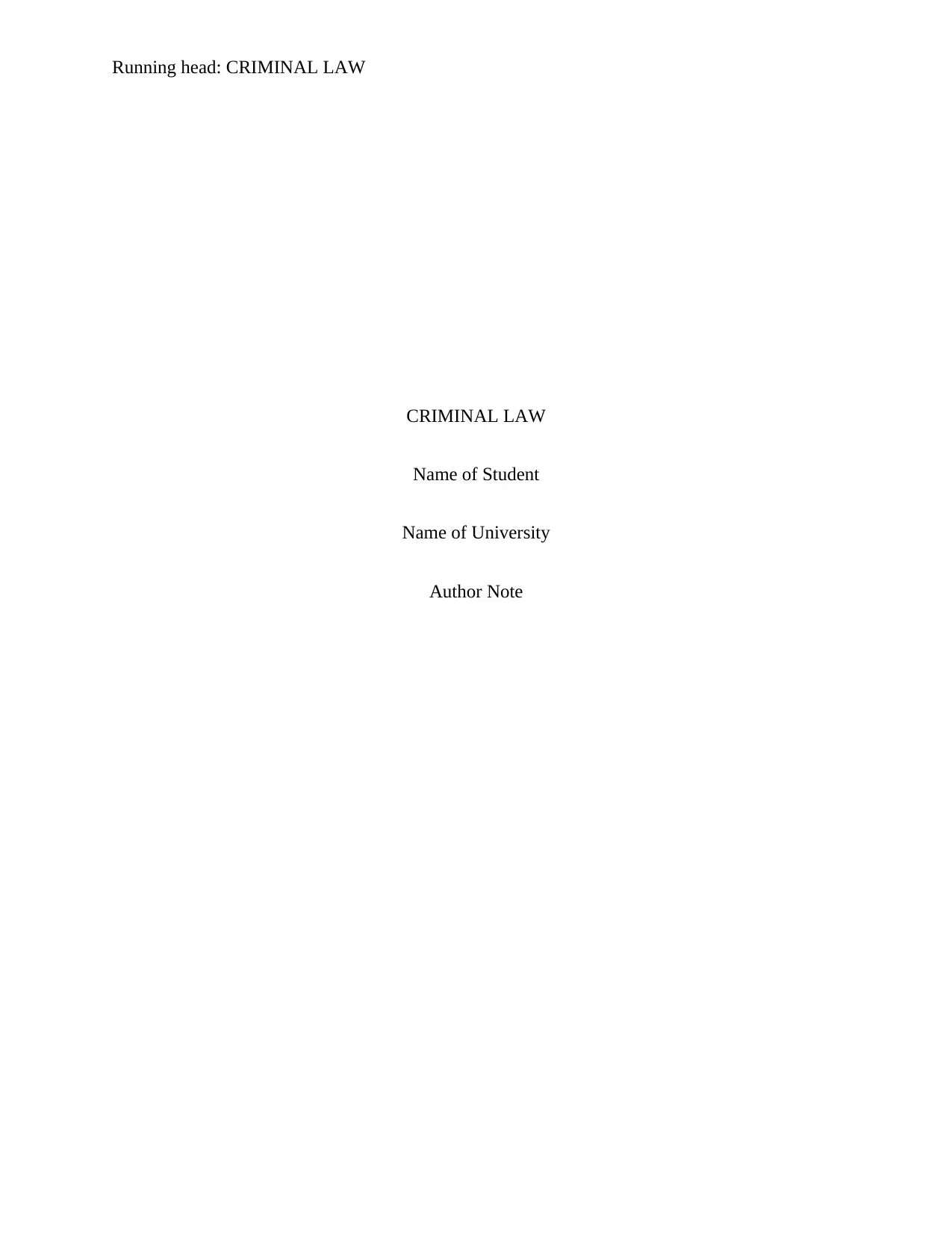
Running head: CRIMINAL LAW
CRIMINAL LAW
Name of Student
Name of University
Author Note
CRIMINAL LAW
Name of Student
Name of University
Author Note
Secure Best Marks with AI Grader
Need help grading? Try our AI Grader for instant feedback on your assignments.
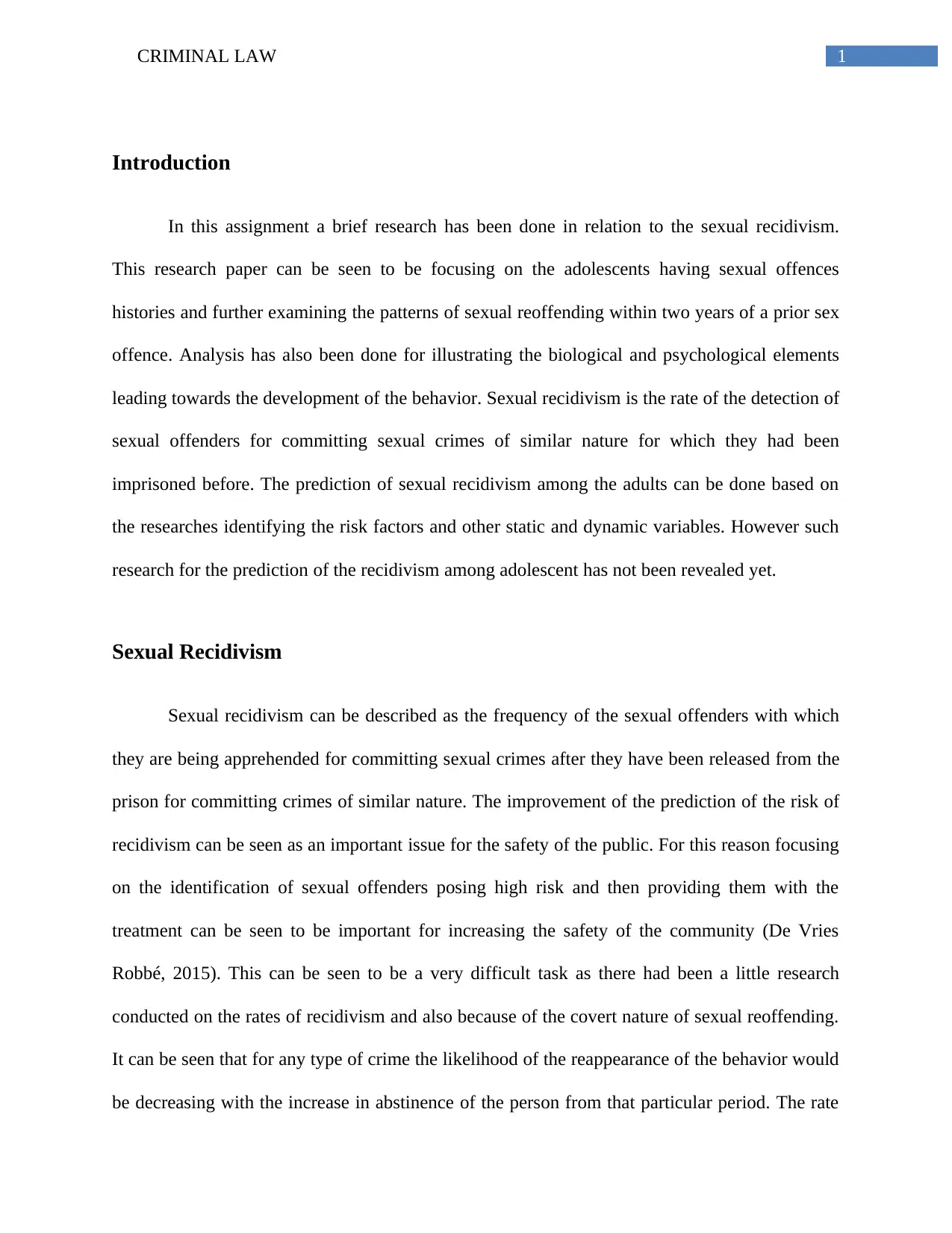
1CRIMINAL LAW
Introduction
In this assignment a brief research has been done in relation to the sexual recidivism.
This research paper can be seen to be focusing on the adolescents having sexual offences
histories and further examining the patterns of sexual reoffending within two years of a prior sex
offence. Analysis has also been done for illustrating the biological and psychological elements
leading towards the development of the behavior. Sexual recidivism is the rate of the detection of
sexual offenders for committing sexual crimes of similar nature for which they had been
imprisoned before. The prediction of sexual recidivism among the adults can be done based on
the researches identifying the risk factors and other static and dynamic variables. However such
research for the prediction of the recidivism among adolescent has not been revealed yet.
Sexual Recidivism
Sexual recidivism can be described as the frequency of the sexual offenders with which
they are being apprehended for committing sexual crimes after they have been released from the
prison for committing crimes of similar nature. The improvement of the prediction of the risk of
recidivism can be seen as an important issue for the safety of the public. For this reason focusing
on the identification of sexual offenders posing high risk and then providing them with the
treatment can be seen to be important for increasing the safety of the community (De Vries
Robbé, 2015). This can be seen to be a very difficult task as there had been a little research
conducted on the rates of recidivism and also because of the covert nature of sexual reoffending.
It can be seen that for any type of crime the likelihood of the reappearance of the behavior would
be decreasing with the increase in abstinence of the person from that particular period. The rate
Introduction
In this assignment a brief research has been done in relation to the sexual recidivism.
This research paper can be seen to be focusing on the adolescents having sexual offences
histories and further examining the patterns of sexual reoffending within two years of a prior sex
offence. Analysis has also been done for illustrating the biological and psychological elements
leading towards the development of the behavior. Sexual recidivism is the rate of the detection of
sexual offenders for committing sexual crimes of similar nature for which they had been
imprisoned before. The prediction of sexual recidivism among the adults can be done based on
the researches identifying the risk factors and other static and dynamic variables. However such
research for the prediction of the recidivism among adolescent has not been revealed yet.
Sexual Recidivism
Sexual recidivism can be described as the frequency of the sexual offenders with which
they are being apprehended for committing sexual crimes after they have been released from the
prison for committing crimes of similar nature. The improvement of the prediction of the risk of
recidivism can be seen as an important issue for the safety of the public. For this reason focusing
on the identification of sexual offenders posing high risk and then providing them with the
treatment can be seen to be important for increasing the safety of the community (De Vries
Robbé, 2015). This can be seen to be a very difficult task as there had been a little research
conducted on the rates of recidivism and also because of the covert nature of sexual reoffending.
It can be seen that for any type of crime the likelihood of the reappearance of the behavior would
be decreasing with the increase in abstinence of the person from that particular period. The rate
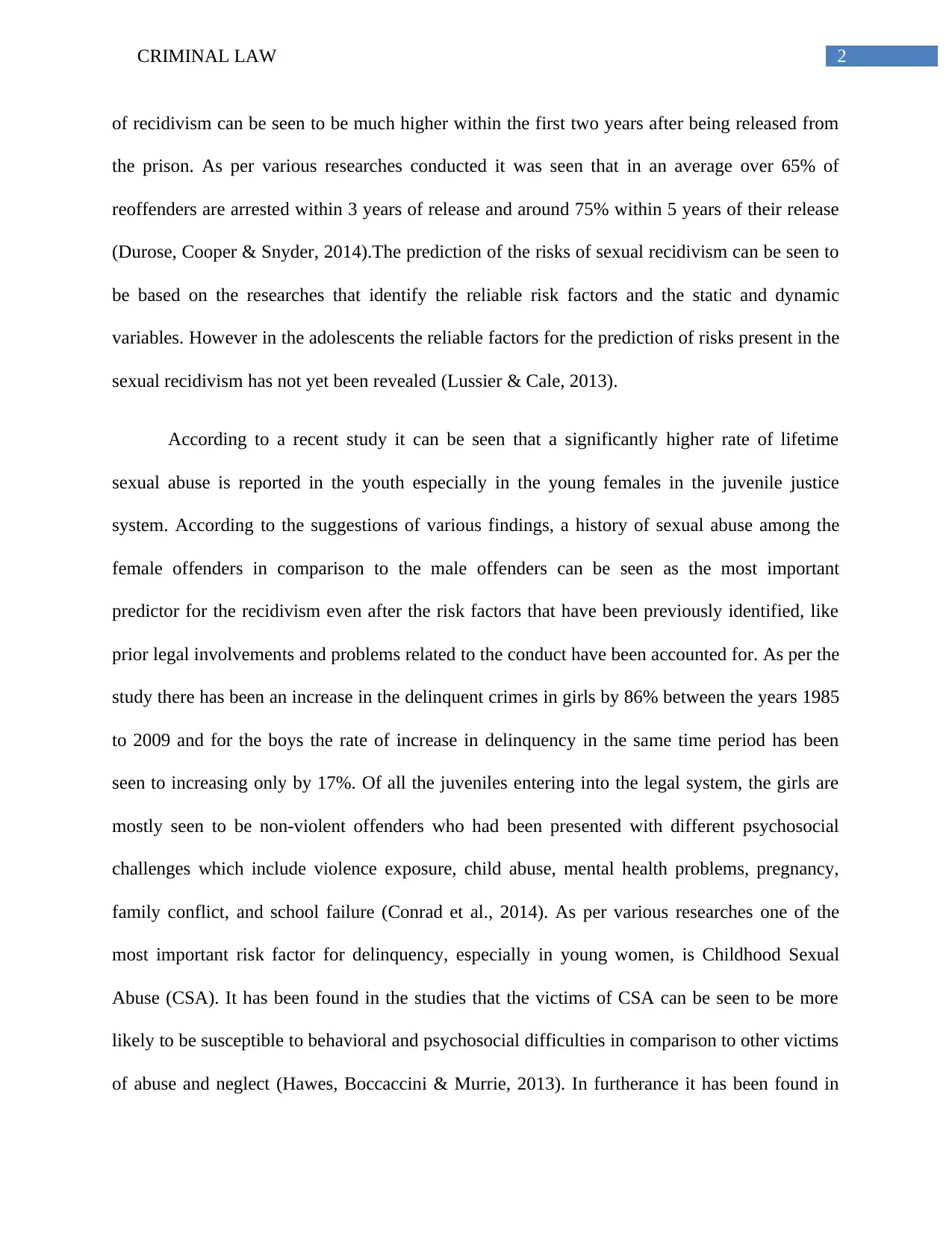
2CRIMINAL LAW
of recidivism can be seen to be much higher within the first two years after being released from
the prison. As per various researches conducted it was seen that in an average over 65% of
reoffenders are arrested within 3 years of release and around 75% within 5 years of their release
(Durose, Cooper & Snyder, 2014).The prediction of the risks of sexual recidivism can be seen to
be based on the researches that identify the reliable risk factors and the static and dynamic
variables. However in the adolescents the reliable factors for the prediction of risks present in the
sexual recidivism has not yet been revealed (Lussier & Cale, 2013).
According to a recent study it can be seen that a significantly higher rate of lifetime
sexual abuse is reported in the youth especially in the young females in the juvenile justice
system. According to the suggestions of various findings, a history of sexual abuse among the
female offenders in comparison to the male offenders can be seen as the most important
predictor for the recidivism even after the risk factors that have been previously identified, like
prior legal involvements and problems related to the conduct have been accounted for. As per the
study there has been an increase in the delinquent crimes in girls by 86% between the years 1985
to 2009 and for the boys the rate of increase in delinquency in the same time period has been
seen to increasing only by 17%. Of all the juveniles entering into the legal system, the girls are
mostly seen to be non-violent offenders who had been presented with different psychosocial
challenges which include violence exposure, child abuse, mental health problems, pregnancy,
family conflict, and school failure (Conrad et al., 2014). As per various researches one of the
most important risk factor for delinquency, especially in young women, is Childhood Sexual
Abuse (CSA). It has been found in the studies that the victims of CSA can be seen to be more
likely to be susceptible to behavioral and psychosocial difficulties in comparison to other victims
of abuse and neglect (Hawes, Boccaccini & Murrie, 2013). In furtherance it has been found in
of recidivism can be seen to be much higher within the first two years after being released from
the prison. As per various researches conducted it was seen that in an average over 65% of
reoffenders are arrested within 3 years of release and around 75% within 5 years of their release
(Durose, Cooper & Snyder, 2014).The prediction of the risks of sexual recidivism can be seen to
be based on the researches that identify the reliable risk factors and the static and dynamic
variables. However in the adolescents the reliable factors for the prediction of risks present in the
sexual recidivism has not yet been revealed (Lussier & Cale, 2013).
According to a recent study it can be seen that a significantly higher rate of lifetime
sexual abuse is reported in the youth especially in the young females in the juvenile justice
system. According to the suggestions of various findings, a history of sexual abuse among the
female offenders in comparison to the male offenders can be seen as the most important
predictor for the recidivism even after the risk factors that have been previously identified, like
prior legal involvements and problems related to the conduct have been accounted for. As per the
study there has been an increase in the delinquent crimes in girls by 86% between the years 1985
to 2009 and for the boys the rate of increase in delinquency in the same time period has been
seen to increasing only by 17%. Of all the juveniles entering into the legal system, the girls are
mostly seen to be non-violent offenders who had been presented with different psychosocial
challenges which include violence exposure, child abuse, mental health problems, pregnancy,
family conflict, and school failure (Conrad et al., 2014). As per various researches one of the
most important risk factor for delinquency, especially in young women, is Childhood Sexual
Abuse (CSA). It has been found in the studies that the victims of CSA can be seen to be more
likely to be susceptible to behavioral and psychosocial difficulties in comparison to other victims
of abuse and neglect (Hawes, Boccaccini & Murrie, 2013). In furtherance it has been found in
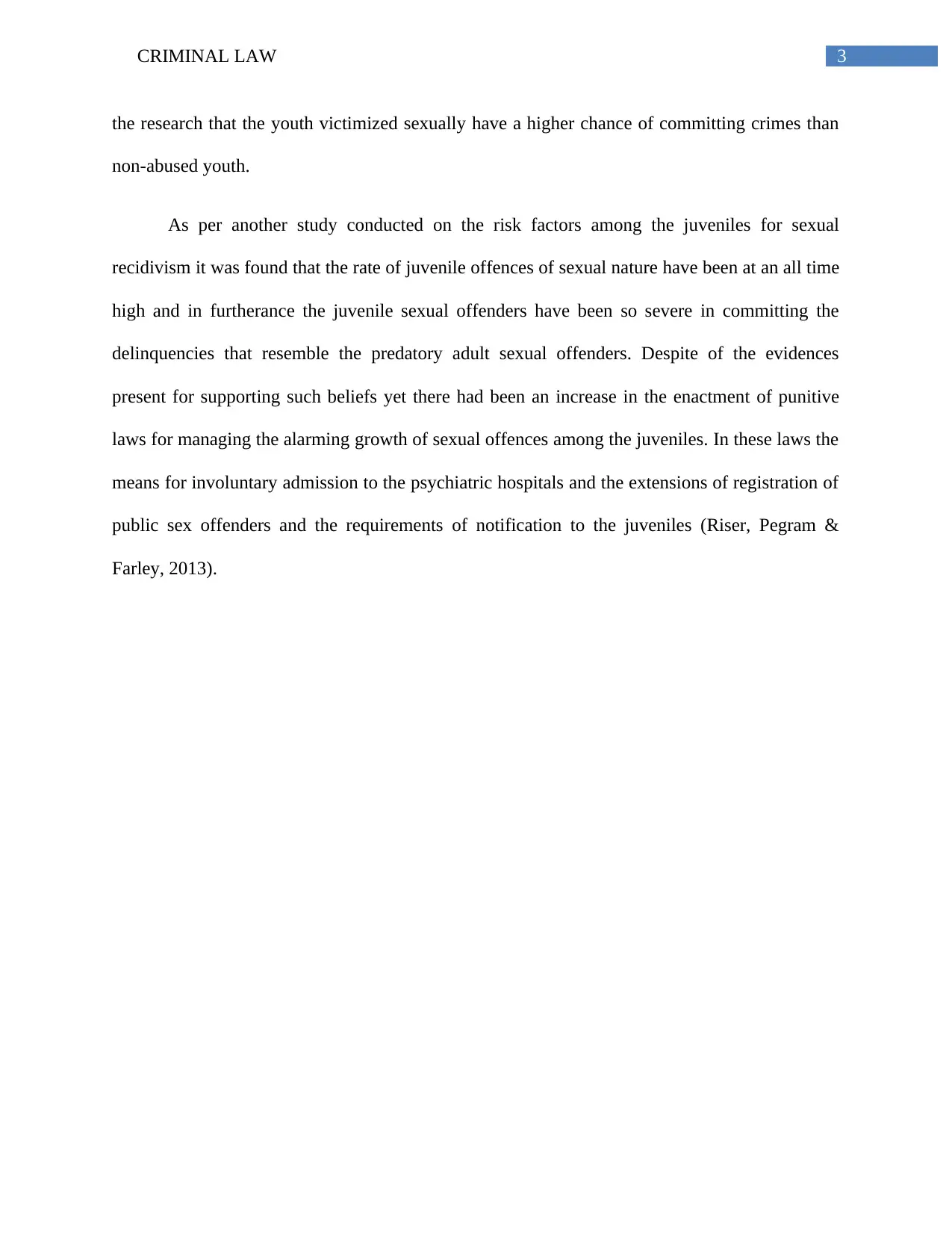
3CRIMINAL LAW
the research that the youth victimized sexually have a higher chance of committing crimes than
non-abused youth.
As per another study conducted on the risk factors among the juveniles for sexual
recidivism it was found that the rate of juvenile offences of sexual nature have been at an all time
high and in furtherance the juvenile sexual offenders have been so severe in committing the
delinquencies that resemble the predatory adult sexual offenders. Despite of the evidences
present for supporting such beliefs yet there had been an increase in the enactment of punitive
laws for managing the alarming growth of sexual offences among the juveniles. In these laws the
means for involuntary admission to the psychiatric hospitals and the extensions of registration of
public sex offenders and the requirements of notification to the juveniles (Riser, Pegram &
Farley, 2013).
the research that the youth victimized sexually have a higher chance of committing crimes than
non-abused youth.
As per another study conducted on the risk factors among the juveniles for sexual
recidivism it was found that the rate of juvenile offences of sexual nature have been at an all time
high and in furtherance the juvenile sexual offenders have been so severe in committing the
delinquencies that resemble the predatory adult sexual offenders. Despite of the evidences
present for supporting such beliefs yet there had been an increase in the enactment of punitive
laws for managing the alarming growth of sexual offences among the juveniles. In these laws the
means for involuntary admission to the psychiatric hospitals and the extensions of registration of
public sex offenders and the requirements of notification to the juveniles (Riser, Pegram &
Farley, 2013).
Secure Best Marks with AI Grader
Need help grading? Try our AI Grader for instant feedback on your assignments.
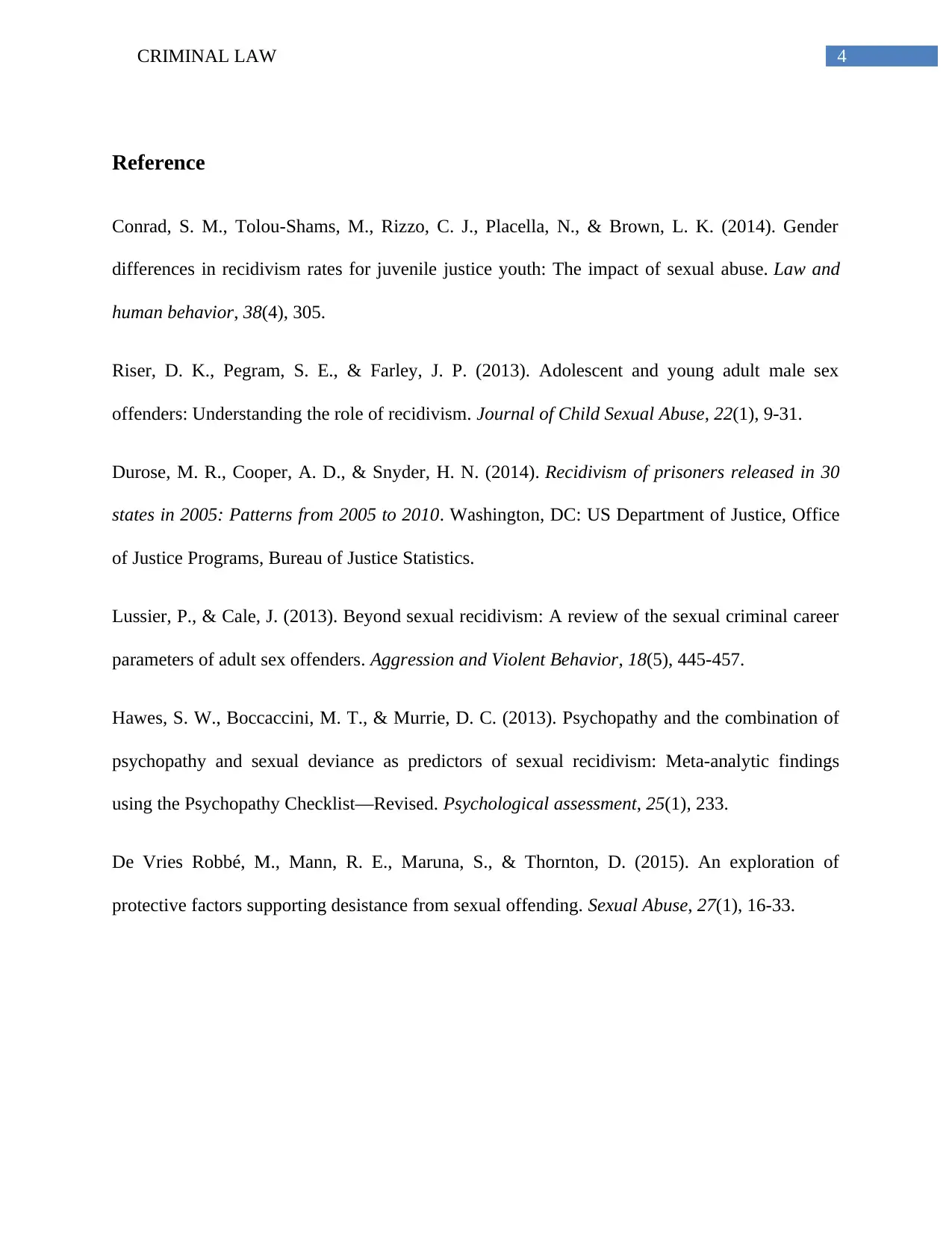
4CRIMINAL LAW
Reference
Conrad, S. M., Tolou-Shams, M., Rizzo, C. J., Placella, N., & Brown, L. K. (2014). Gender
differences in recidivism rates for juvenile justice youth: The impact of sexual abuse. Law and
human behavior, 38(4), 305.
Riser, D. K., Pegram, S. E., & Farley, J. P. (2013). Adolescent and young adult male sex
offenders: Understanding the role of recidivism. Journal of Child Sexual Abuse, 22(1), 9-31.
Durose, M. R., Cooper, A. D., & Snyder, H. N. (2014). Recidivism of prisoners released in 30
states in 2005: Patterns from 2005 to 2010. Washington, DC: US Department of Justice, Office
of Justice Programs, Bureau of Justice Statistics.
Lussier, P., & Cale, J. (2013). Beyond sexual recidivism: A review of the sexual criminal career
parameters of adult sex offenders. Aggression and Violent Behavior, 18(5), 445-457.
Hawes, S. W., Boccaccini, M. T., & Murrie, D. C. (2013). Psychopathy and the combination of
psychopathy and sexual deviance as predictors of sexual recidivism: Meta-analytic findings
using the Psychopathy Checklist—Revised. Psychological assessment, 25(1), 233.
De Vries Robbé, M., Mann, R. E., Maruna, S., & Thornton, D. (2015). An exploration of
protective factors supporting desistance from sexual offending. Sexual Abuse, 27(1), 16-33.
Reference
Conrad, S. M., Tolou-Shams, M., Rizzo, C. J., Placella, N., & Brown, L. K. (2014). Gender
differences in recidivism rates for juvenile justice youth: The impact of sexual abuse. Law and
human behavior, 38(4), 305.
Riser, D. K., Pegram, S. E., & Farley, J. P. (2013). Adolescent and young adult male sex
offenders: Understanding the role of recidivism. Journal of Child Sexual Abuse, 22(1), 9-31.
Durose, M. R., Cooper, A. D., & Snyder, H. N. (2014). Recidivism of prisoners released in 30
states in 2005: Patterns from 2005 to 2010. Washington, DC: US Department of Justice, Office
of Justice Programs, Bureau of Justice Statistics.
Lussier, P., & Cale, J. (2013). Beyond sexual recidivism: A review of the sexual criminal career
parameters of adult sex offenders. Aggression and Violent Behavior, 18(5), 445-457.
Hawes, S. W., Boccaccini, M. T., & Murrie, D. C. (2013). Psychopathy and the combination of
psychopathy and sexual deviance as predictors of sexual recidivism: Meta-analytic findings
using the Psychopathy Checklist—Revised. Psychological assessment, 25(1), 233.
De Vries Robbé, M., Mann, R. E., Maruna, S., & Thornton, D. (2015). An exploration of
protective factors supporting desistance from sexual offending. Sexual Abuse, 27(1), 16-33.
1 out of 5
Related Documents
Your All-in-One AI-Powered Toolkit for Academic Success.
+13062052269
info@desklib.com
Available 24*7 on WhatsApp / Email
![[object Object]](/_next/static/media/star-bottom.7253800d.svg)
Unlock your academic potential
© 2024 | Zucol Services PVT LTD | All rights reserved.





